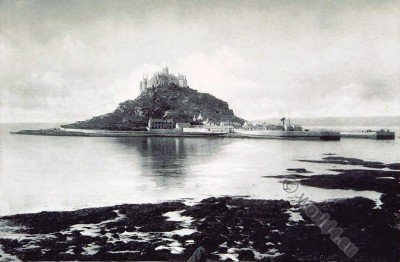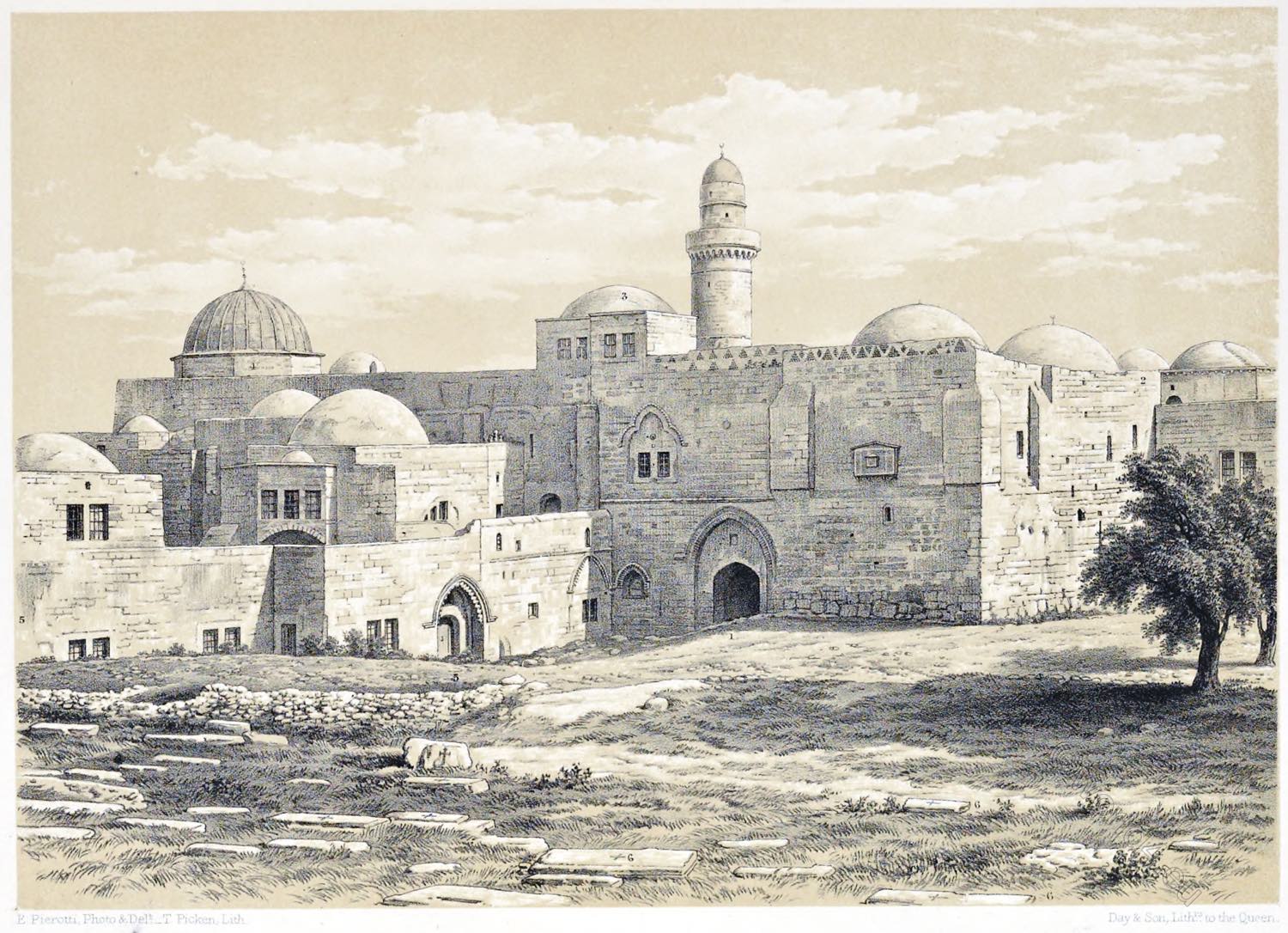St Michael’s Mount
St. Michael’s Mount (Cornish: Garrel Los y ‘Cos) is a tidal island on the southwestern tip of England, which is 366 m before the village Marazion in Cornwall and has an area of 0.23 km².
St Michael’s Mount
THIS is a pyramidal isolated granite crag, in the parish of St. Hilary, 195 feet high and 5 furlongs in circumference, standing in Mounts Bay, E. of Penzance. It is said to have been cut off from the mainland by a mighty inundation which occurred in 1099, and is now joined to the shore only by a low causeway, 560 yards long, of land which is covered by the tide for sixteen hours out of the twenty-four.
The hill is crowned with an ancient building originally founded by Edward the Confessor as a priory for Benedictine monks, and which in after years was fortified. The first military occupation of this structure was effected by Henry de Pomeroy, who, having during the absence of King Richard I. at the Holy War assisted the usurping Prince John, was summoned by the vicegerent, Bishop Longchamp, from Berry Pomeroy (q.v., Devon).
He, however, stabbed the messenger, and then fled to his castle of Tregony, the strength of which mistrusting, he thence proceeded with some followers to the Mount, where the party, disguised as pilgrims, introduced themselves into the monastic buildings, seized and fortified them, and remained there for several months.
On the return of the king from his Austrian prison, Pomeroy, fearing the consequences, is said to have bled himself to death, and the Mount was surrendered to Walter, Archbishop of Canterbury, the Chancellor, who was sent to regain the place (1194). The king then restored the monks, placing a small garrison at the Mount to guard it in future.
This Henry de Pomeroy being the grandson of the illegitimate daughter of Henry I., was thus a relation of Richard I. and his brother John. The next we hear of the place is its capture in the fifteenth century by John, 13th Earl of Oxford, on fleeing from the battle of Barnet (1471). He came to Wales, and taking ship coasted round the S. coast to this place, where his grandfather had acquired possession. Here, after the example of Pomeroy, Oxford and his men, disguising themselves, obtained admission and seized the fortress, occupying it as they alleged for King Henry.
Edward IV. at once sent a force under Sir John Arundel, the sheriff, to besiege and reduce Mount: Oxford, however, refusing to surrender, made a vigorous resistance, driving the besiegers back on the sands, where the sheriff and some of his men were killed.
Thereon a new sheriff was despatched against Oxford, who again repulsed the force with loss, and on this being reported to the king he sent to learn on what terms Oxford would surrender. He demanded their lives, liberties, and lands, and Edward granted the terms asked, whereupon the fortress was delivered up. But the earl was sent prisoner to Ham in France where he lived till the expedition of the Earl of Richmond against Richard III., which he joined, and, leading the van at Bosworth, was slain.
In the reign of Henry VII. Perkin Warbeck landed here, and on proceeding on his raid in Cornwall left his wife, Lady Catherine Gordon, in security at the Mount. During the Cornish insurrection of 1549 (Edward VI), many of the best families in the West fled for shelter to this stronghold, and were there besieged by the rebels under its governor, Humphrey Arundel. The place was stormed and taken, yielding rich plunder to the victors, who in their turn, however, were driven out.
In the great Civil War the Mount was made, as supposed, impregnable, and was held for King Charles by Sir Arthur Basset, but in April 1646 the Parliamentary troops, under Colonel Hammond, succeeded after a siege of fifteen days inreducing the place, when fifteen guns and 400 stand of arms fell into their hands (Sprigg).
A steep and difficult path leads up to the summit, defended midway by a battery, with another battery at the top. The church crowns the crest of the hill, surrounded by the old monastic buildings. On the centre tower is a turret once used as a beacon for sailors, and on the S.W. angle of this, overhanging the sea, is the famous seat called St. Michael’s Chair. The whole structure has for long been the property of the St. Aubyn family (Lord St. Levan), and has been adapted to form a comfortable modern dwelling. It is a castellated house, retaining much of the monastic masonry, but great alterations were made in it during last century; the dining-room was the refectory of the convent, and the chapel has been fitted up in the Gothic style.
Queen Elizabeth granted the manor to Thomas Bellot, who conveyed it to Cecil, Earl of Salisbury; then, when forfeited by that family, King Charles gave it to the Bassets of Tehidy, but at the Restoration the St. Aubyn family purchased it from them and made it ever since their principal residence.
Source: The Castles of England: their story and structure by James D. Mackenzie, Baronet of Scatwell and Tarbat. Published by W. Heinemann. London 1897.
Related to:
History of England
- Celt and Roman. History of England 43 BC to 440 AD.
- Celtic relics, ornaments of gold and bronze.
- Roman Britain. Maps, Places, Tribes. Historical atlas.
- Alfred the Great Viking chieftain.
- Alfred the Great. The first English king.
- King Harold II. Last Anglo-Saxon king of England.
- King James I of England, son of Mary Stuart, Queen of Scots.
- Sir Thomas More.
- Thomas Becket. Archbishop of Canterbury.
- John Wycliffe and the Dawn of the Reformation.
- William Caxton and the art of printing.
- Bloody Mary, the daughter of Henry VIII.
- The character of Henry VIII. Tudor King of England.
- The reign of Elizabeth. The days of Queen Bess.
- Tudor Queen. The offer of the crown to Lady Jane Grey.
- Mary Queen of Scots at Lochleven Castle.
- Sir Francis Drake.
- The english boy king Edward VI.
- Relics associated with Queen Elisabeth.
- The departure of the Mayflower.
- Charles I of England. King and Martyr.
- The English Civil War 1642-1649.
- The Battle of Marston Moor on 2 July 1644 .
- Charles the first in the guard room.
- Oliver Cromwell. The Protector.
- The Escape of Charles II. with Jane Lane.
- Pictures and Royal Portraits Illustrative of English and Scottish History:
Discover more from World4 Costume Culture History
Subscribe to get the latest posts sent to your email.



